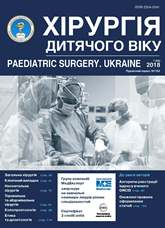Minimally invasive surgical interventions in acute necrotising pancreatitis (a literature review)
DOI:
https://doi.org/10.15574/PS.2018.58.101Keywords:
acute destructive pancreatitis, minimally invasive interventions, step-up-approachAbstract
Acute pancreatitis is one of the biggest problems of emergency abdominal surgery. Destructive (necrotic) forms make up about 20% in its structure, and in particular they cause the greatest number of morphological local and systemic complications as well as mortality. The last decade has been characterized by the large-scale implementation of minimally invasive technologies for the acute pancreatitis treatment, the step-by-step use of which greatly improved the treatment outcomes. The article highlights the step-up-approach for treatment of the destructive forms of acute pancreatitis.References
Mishalov VG, Markulan LYu., Matveev RM. (2015). Results of treatment of patients with acute pancreatitis. Surgery of Ukraine. 1: 84-89.
On Approval of Standards and Clinical Protocols for the Provision of Medical Aid in the Specialty Surgery. Order of the Ministry of Health of Ukraine No.297 2010.
Khomyak IV. (2010). Differentiated stage surgical treatment of acute necrotizing pancreatitis: Author's abstract. Dis … doctor of medical science: 43.
Ammori BJ. (2002). Laparoscopic transgastric pancreatic necrosectomy for infected pancreatic necrosis. Surg. Endosc. 16(9): 1362.
Banks PA, Thomas LB, Christos D (2013). Classification of acute pancreatitis – 2012: revision of Atlanta classification and definitions by international consensus. Gut. 62: 102–111.
Baudin G, Chassang M, Gelsi E. (2012). CT-Guided Drainage of Acute Necrotizing Pancreatitis. AJR. 199: 192–199.
Bruennler T, Langgartner J, Hamer OW. (2008). Outcome of patients with acute necrotizing pancreatitis requiring drainage-does drainage size matter?. World J Gastroenterol. 14(5): 725–730.
Cheung MT, Ho CN, Siu KW. (2005). Percutaneous drainage and necrosectomy in the management of pancreatic necrosis. ANZ J Surg. 75(4): 204–207.
Dua MM Worhunsky DJ, Tran TB. (2015). Surgical Strategies for the Management of Necrotizing Pancreatitis. J Pancreas. 16(6): 547-558.
Endoscopic transluminal pancreatic necrosectomy. NICE Interventional procedures guidance. Published: 23 November 2016. https:// nice.org.uk/guidance/ipg567.
Ferrada PA, Anand RJ. (2012). Step-up Approach for Pancreatic Necrosis: A Case Report and Review of the Technique and Literature. Panamerican Journal of Trauma, Critical Care & Emergency Surgery. 1(3): 206-209.
Freeny P.C Hauptmann E, Althaus SJ. (1998). Percutaneous CT-guided catheter drainage of infected acute necrotizing pancreatitis: techniques and results. AJR Am J Roentgenol. 170(4): 969–975.
Haas B, Nathens AB. (2010). Surgical indications in acute pancreatitis. Current Opinion in Critical Care. 16: 153–158.
Hollemans A, Freeman ML, Van Santvoort HC. Endoscopic treatment to infected necrosis. Pancreapedia: Exocrine Pancreas Knowledge Base. doi 10.3998/panc.2016.20
Hollemans A, Bollen TL, Van Brunschot S. (2016). Predicting success of catheter drainage in infected necrotizing pancreatitis. Ann Surg. 263(4): 787–792.
Horvath KD, Kao LS, Wherry KL. (2001). A technique for laparoscopic-assisted percutaneous drainage of іnfected pancreaticnecrosis and pancreatic abscess. Surg Endosc. 15(10): 1221–1225.
Lichi K, Junhua L, Peihong H. (2016). Percutaneous сatheter drainage in infected pancreatitis necrosis: a systematic review. Indian J Surg. 78(3): 221–228.
Machado NO, Machado NN. (2014). “Step Up” Approach in the Management of Pancreatic Necrosis. Is it A Step in the Right Direction? Pancreat Disord Ther. 4: 136.
Mittu JM, Amit PK. (2014). Laparoscopic necrosectomy in acute necrotizing pancreatitis: Our experience. J Minim Access Surg. 10(3): 126–131.
Pamoukian VN, Gagner M. (2001). Laparoscopic necrosectomy for acute necrotizing pancreatitis. J Hepatobiliary Pancreat. Surg. 8: 221–223.
Seifert H, Biermer M, Schmitt W. (2009). Transluminal endoscopic necrosectomy after acute pancreatitis: a multicentre study with long-termfollow-up (the GEPARD Study). Gut. 58: 1260–1266.
Tenner S, Baillie J. (2013). American College of Gastroenterology Guideline (ACG): Management of Acute Pancreatitis. Am J Gastroenterol. 108: 1400–1415. https://doi.org/10.1038/ajg.2013.218; https://doi.org/10.1038/ajg.2013.246
Tonsi AF, Bacchion M, Bassi C. (2009). Acute pancreatitis at the beginning of the 21st century: The state of the art. World J Gastroenterol. 15(24): 2945–59.
Tyberg A, Karia K, Gabr M. (2016). Management of pancreatic fluid collections: A comprehensive review of the literature. World J Gastroenterol. 22(7): 2256-2270.
Van Baal MC, Van Santvoort HC, Bollen TL. (2011). Systematic review of percutaneous catheter drainage as primary treatment for necrotizing pancreatitis. British Journal of Surgery. 98: 18–27.
Van Brunschot S, Van Grinsven J, Voermans RP et.al. (2013) Transluminal endoscopic step-up approach versus minimally invasive surgical step-up approach in patients with infected necrotising pancreatitis (TENSION trial): design and rationale of a randomised controlled multicenter trial. BMC Gastroenterology. 13: 161.
Van Brunschot S, Besselink MG, Bakker OJ. (2013). Video-Assisted Retroperitoneal Debridement (VARD) of Infected Necrotizing Pancreatitis: An Update. Curr Surg Rep. 1: 121–130.
Van Santvoort HC, Besselink MG, Bakker OJ. (2010). A Step-up approach or open necrosectomy for necrotizing pancreatitis. The New England Journal of Medicine. 362(16): 1491-502.
Working Group IAP/APA evidence-based guidelines for the management of acute pancreatitis (2013). Pancreatology. 13: e1-e15.
Yip HC, Teoh AY. (2017). Endoscopic management of peri-pancreatic fluid collections. Gut and Liver. Published online: https://doi.org/10.5009/gnl16178. May 12. https://doi.org/10.5009/gnl16178
Zenati KM, Khreiss M, Clifford A. (2015). Cyst Gastrostomy and Necrosectomy for the Management of Sterile Walled-Off PancreaticNecrosis: a Comparison of Minimally Invasive Surgical and Endoscopic Outcomes at a High-Volume Pancreatic Center. J Gastrointest.Surg. 19(8): 1441-1448.
Downloads
Issue
Section
License
The policy of the Journal “PAEDIATRIC SURGERY. UKRAINE” is compatible with the vast majority of funders' of open access and self-archiving policies. The journal provides immediate open access route being convinced that everyone – not only scientists - can benefit from research results, and publishes articles exclusively under open access distribution, with a Creative Commons Attribution-Noncommercial 4.0 international license(СС BY-NC).
Authors transfer the copyright to the Journal “PAEDIATRIC SURGERY.UKRAINE” when the manuscript is accepted for publication. Authors declare that this manuscript has not been published nor is under simultaneous consideration for publication elsewhere. After publication, the articles become freely available on-line to the public.
Readers have the right to use, distribute, and reproduce articles in any medium, provided the articles and the journal are properly cited.
The use of published materials for commercial purposes is strongly prohibited.

